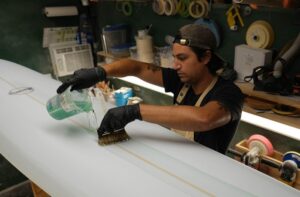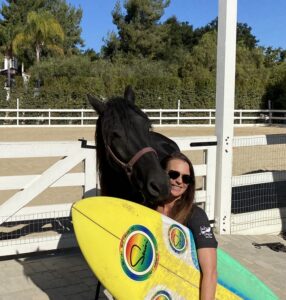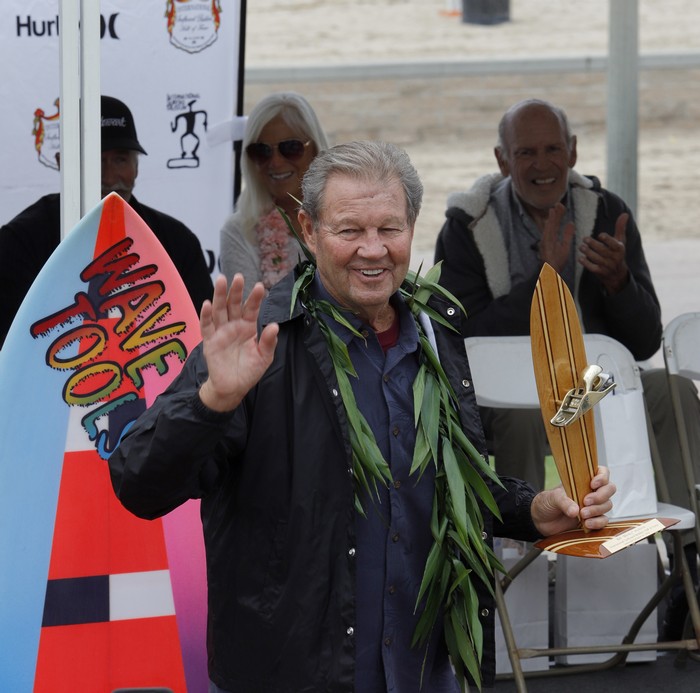Bill Hubina has long been a fixture in the Ventura surf community. Photo by Cecilia Ortiz @thepixelchick
by Amy Brown
In the 1960s, surfing was still in its relative infancy along the California coast. The ‘Sport of Kings’ started in ancient Polynesia, and had a surge of U.S. mainstream popularity in the Post-Vietnam war, as it gravitated from Waikiki to Malibu. The next few years were referred to as the Golden Age of surfing, as surfing gained momentum, media visibility and exponentially evolved. Meanwhile, Ventura was blossoming with its peeling point, reef and beach breaks and a small but seriously stoked cadre of enthusiasts was putting the sport and the city on the map.
One of them was Bill “Blinky” Hubina, now owner of Ventura Surf Shop, who was recently inducted into the International Surfboard Builders Hall of Fame. He moved to Ventura in 1961 to attend Ventura College, but his academic fervor quickly gave way to following his real passion on the waves. “It was the very beginning back then, there were probably only ten major surf shops on the whole California coast at that time, “ he said. “With the boom of the Golden Age, Ventura soon had a major surfboard business on Callens Road, Ventura International Plastics, that made mass production surfboards sold all across the country.”
Hubina and his friends didn’t have wetsuits in the 1960s, and while there were not yet a lot of surfers, when they came they were welcomed. “Mile for mile, we have more surf here than any other place on the coast,” said Hubina. Around that time he created what he calls the first short board in Ventura—by accident. “I was broke, and wanted a new board but didn’t have enough money. I was doing repairs and had a blank that I’d sawed the nose off to repair and then sawed the tail off to put on another board. I made a shorter longboard that was 7’11 that I took to C Street and was amazed at how it surfed; all my friends wanted to ride it. That started my career of making short boards.”

For many, surfing is legacy passed down in the family, like Bobby Biggerstaff, who grew up surfing in Hueneme with his dad, who learned from his father. Biggerstaff is now a shaper for Fletcher Chouinard, a surf division of Patagonia, but started making boards in the garage with his father. “It started because of my dad, and because boards are so expensive. My dad has a DIY mentality,” said Biggerstaff. “You don’t have to have a pro’s name on a board to make you surf better.” He says his family has seen the local surfing culture change and grow over the years. “Back when my dad was young, the Strand was super local spot. You kind of had to be more respectful in the water and more aware. Now it’s a bit more of a free for all.” He suggests that if someone is just learning to surf, it’s a good idea to hire someone to show them the ropes and learn safety rules and etiquette. “Surfing is for everyone. No matter where you’re from, your skin color, how you identify, there’s a place for you in surfing. You need to know the rules of the road—it’s kind of like driving a car, if you’re out of your lane or cutting people off, you can seriously hurt someone. It’s important to learn the right way.”

Learning the right way is a legacy that can come from strangers in the lineup and can grow to include ocean literacy and social responsibility, according to Nancy Cairns. She been surfing in Ventura for 20 years, and remains grateful for the folks that were willing to help her learn. She joined local groups that focus on surfing and environmental and social responsibility. “That’s really grown in Ventura’s culture of surfing, activism around surfing is about maintaining and preserving our environment. I’m really impressed with the younger generation that are activists, protecting our environment and wanting to engage people with disabilities and get them connected with surfing, with something that will change their lives.”

